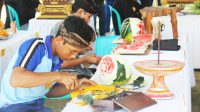TIME has changed and so does Balinese farmers’ activity in the fields. As an island not only known for its vibrant culture and stunning landscapes, Bali is also renowned for its rich agricultural heritage. One of the traditional practices having shaped the island’s rural life for centuries is cow-driven plowing, a method used by farmers to cultivate the land before the advent of modern machinery.
While this practice is now rare, having been replaced by hand tractors, it is making a comeback—but with a twist. Today, cow-driven plowing is being offered as a unique tourist experience, allowing visitors to step back in time and witness traditional farming methods in action.
Tradition of Cow-Driven Plowing
For generations, Balinese farmers used cows to plow their rice fields, a system that relies on teamwork between the farmer and his cattle. With wooden plows attached to the cows, they would skillfully navigate the muddy fields, turning the soil in preparation for planting. This slow, rhythmic process is not only labor-intensive but also deeply intertwined with Bali’s cultural values of balance and harmony with nature.
As technology advanced, cow-driven plowing began to fade. The introduction of hand tractors has made land cultivation faster and more efficient. However, the traditional method holds a special place in the hearts of Balinese farmers, symbolizing an intimate connection with the land and the animals that help sustain their livelihoods.
From Farming Tool to Tourist Attraction
As modern agriculture tools took over, many farmers found that their cows were no longer needed for plowing. Rather than let this ancient tradition disappear, enterprising farmers in rural Bali saw an opportunity to turn this age-old practice into an agro-tourism attraction.
Now, tourists can visit these farms and participate in plowing the fields the old-fashioned way, using cows to experience the labor and the rich culture tied to traditional farming.
Tourists are invited to don traditional farmer attire, step barefoot into the muddy fields, and guide the cows as they pull the plow through the soil. It’s a hands-on experience that offers a glimpse into the past, allowing travelers to connect with Bali’s farming roots and appreciate the hard work that goes into rice cultivation.
Cows in Modern Balinese Farming
As cow-driven plowing became less necessary for farming, the role of cows in Balinese agriculture shifted. Today, instead of plowing, many cows are raised for fattening, a practice that helps farmers build family savings. Cows are seen as valuable assets in Bali, often considered a form of investment.
When a family needs funds for important events such as religious ceremonies, weddings, or schooling, they can sell a cow to cover expenses. This practice of cow fattening ensures that the animals still play an important economic role, even though their days of plowing fields are mostly behind them.
A Win-Win for Farmers and Tourists
This transformation of cow-driven plowing from a labor necessity to a tourist attraction has brought about a new source of income for farmers. With increasing interest from travelers seeking authentic cultural experiences, many farms have embraced agro-tourism. Offering this activity allows farmers to preserve their traditions while benefiting from tourism.
For tourists, it’s an unforgettable opportunity to participate in a dying tradition while enjoying the picturesque surroundings of Bali’s rural landscapes. It’s not just about the physical act of plowing; it’s about understanding the cultural significance of these traditions and their role in shaping the island’s agricultural history.
Cultural and Environmental Impact
Beyond the economic benefits, this practice helps to keep Bali’s agricultural traditions alive. By offering cow-driven plowing as a tourist attraction, farmers pass on their knowledge to a global audience, ensuring that this practice, once essential to Bali’s survival, is not forgotten.
The activity also has a low environmental footprint, relying on natural resources rather than fuel-powered machinery, which is a draw for eco-conscious travelers.
Today, a number of tourism villages or community-based tourism groups in Bali take advantage of this tradition as a tourist attraction. Guests are given the opportunity to ride plowing tool or just to watch the activity so as to experience or just witness in person what local farmers did in the past before the presence of the hand tractors.
Conclusion
In today’s fast-paced, technology-driven world, the return of cow-driven plowing as a tourist attraction offers a refreshing reminder of simpler times and sustainable practices. Visitors to Bali have the rare opportunity to experience a slice of traditional rural life, while Balinese farmers benefit from a new source of income and the preservation of their cultural heritage.
What was once a necessity for survival has now become a valuable tourist attraction, where both locals and visitors can appreciate the enduring beauty of Bali’s farming traditions.
This unique interaction between tradition and tourism not only supports local farmers but also provides travelers with an authentic and enriching experience that goes beyond Bali’s beaches and resorts.











